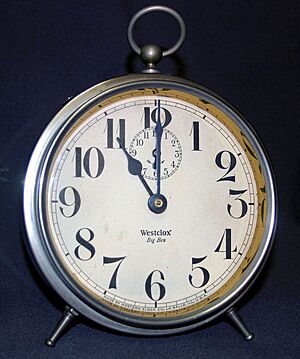12-hour clock facts for kids
The 12-hour clock is a common way to tell time. It divides the 24 hours of a day into two halves. These halves are called a.m. and p.m.. The letters stand for Latin words: ante meridiem (meaning before noon) and post meridiem (meaning after noon).
With the 12-hour clock, we count from 12, then 1, 2, all the way to 11. The time from midnight until noon is a.m. For example, 7:00 a.m. is in the morning. The time from noon until midnight is p.m. So, 7:00 p.m. is in the evening.
Most people around the world use the 12-hour clock in their daily lives. However, some groups, like the military in Canada and the US, use the 24-hour clock system.
How the 12-Hour Clock Works
The 12-hour clock uses the numbers 1 to 12. It repeats these numbers twice a day. The first 12 hours are marked with "a.m." and the next 12 hours are marked with "p.m.".
- a.m. stands for ante meridiem. This means "before midday" or "before noon". So, 1:00 a.m. is one hour after midnight. 11:00 a.m. is one hour before noon.
- p.m. stands for post meridiem. This means "after midday" or "after noon". So, 1:00 p.m. is one hour after noon. 11:00 p.m. is one hour before midnight.
Midnight is usually shown as 12:00 a.m. Noon is shown as 12:00 p.m. This can sometimes be a little confusing!
Comparing 12-Hour and 24-Hour Clocks
The table below helps you see how the 12-hour clock compares to the 24-hour clock. The 24-hour clock counts hours from 00 to 23.
| 24-hour clock | 12-hour clock |
|---|---|
| 00:01 | 12:01 AM |
| 01:00 | 1:00 AM |
| 02:00 | 2:00 AM |
| 03:00 | 3:00 AM |
| 04:00 | 4:00 AM |
| 05:00 | 5:00 AM |
| 06:00 | 6:00 AM |
| 07:00 | 7:00 AM |
| 08:00 | 8:00 AM |
| 09:00 | 9:00 AM |
| 10:00 | 10:00 AM |
| 11:00 | 11:00 AM |
| 12:00 | 12:00 PM |
| 13:00 | 1:00 PM |
| 14:00 | 2:00 PM |
| 15:00 | 3:00 PM |
| 16:00 | 4:00 PM |
| 17:00 | 5:00 PM |
| 18:00 | 6:00 PM |
| 19:00 | 7:00 PM |
| 20:00 | 8:00 PM |
| 21:00 | 9:00 PM |
| 22:00 | 10:00 PM |
| 23:00 | 11:00 PM |
| 00:00 | 12:00 AM |
Images for kids
See also
 In Spanish: Sistema horario de 12 horas para niños
In Spanish: Sistema horario de 12 horas para niños



